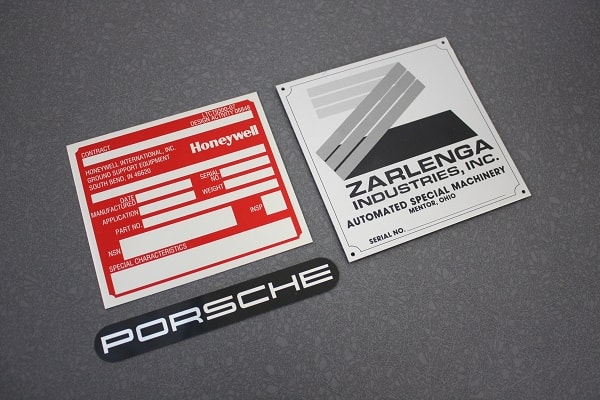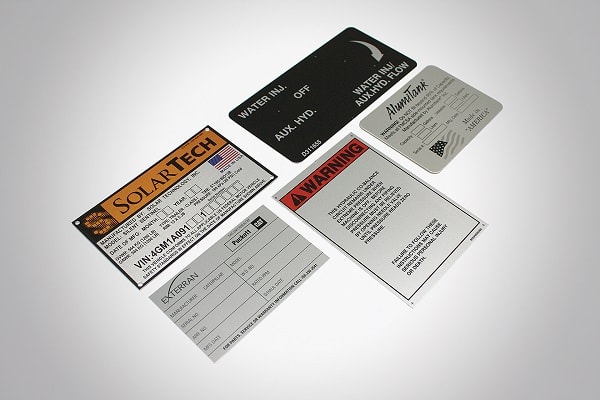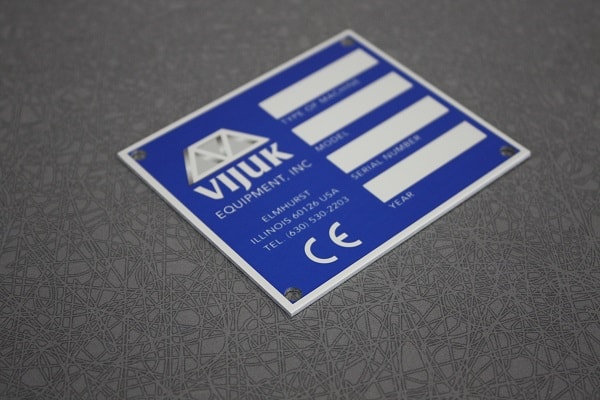Custom nameplates are a great way to mark your products and equipment with a professional and durable solution. Nameplates can be fabricated with either metal or plastic substrates that are chosen based on the environmental conditions expected with your applications. Before placing an order, always check to make sure that you have reviewed all of your requirements and have a clear plan in place.
In this post, we’ll explain the major steps involved in the nameplate design process and how you can choose nameplates that will suit your application’s requirements. With so many options to choose from, it can be challenging to select the design elements that meet your specifications, particularly if you’re not familiar with the durability characteristics of the various substrates and other materials. We hope this guide helps streamline your preparation.

Before you can select specific attributes of a nameplate, it is best to define the requirements of your application. The type of surface, installation location, and environmental conditions can all have an impact on the type of nameplate you should choose. Some of the most important application details to review are:
It becomes much easier to select from the different design parameters when you have these application details in mind. When defining the functional use and environment, be mindful of any potentially hazardous conditions that your nameplates may encounter. Some examples include sources of abrasion, moisture, and extreme heat. These are essential considerations when selecting the material in the next step.

Based on the durability requirements and desired appearance of the nameplate, you can select from a variety of metal and plastic substrate materials. Each will have its own unique characteristics that are well suited for certain applications:

It is now time to define the graphic elements that you require or prefer on the face of your nameplate. Options include text, logos, graphics, and barcodes. It is possible to work with our graphics department to create your design, or you can also submit an AutoCad, Illustrator, or Corel Draw file directly. You can also choose between a black and white design or color graphics.
Another consideration at this stage is the printing method that will be used. There are three major printing technologies for nameplates: screen printing, digital printing, and photo imaging. As an alternative to printing, some metal substrates can also be etched. Each substrate material is optimized for use with particular printing methods, and you should consult the individual specifications for details.
Based on your graphic layout, proof of your nameplate design can be provided for review and approval before the units are created.
In addition to the graphic elements, you can also customize the size, shape, and dimensions of your nameplate. In some cases, you can also select the desired thickness for the substrate material. The attachment methods available for nameplates are a high-strength adhesive or physical attachment that can be done with bolts.
Once your nameplate design is finalized, a prototype can be requested for onsite testing if necessary. From there, you can review any final production questions with our specialists, such as order quantities, repeat orders, or shipping procedures and lead times.
Our process for nameplate design is straightforward for creating a nameplate that meets all of your needs. By following these steps, it is possible to go from an initial application to a finalized nameplate in a short time. We hope you found this post helpful and come away with a few new ideas for your next nameplate design.
Our sales engineers are experts in automatic asset tracking, tagging and identification,a nd can answer all your questions. Get in touch now.
Lets Talk ›